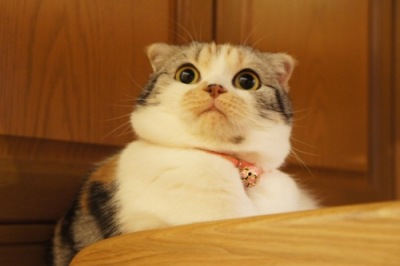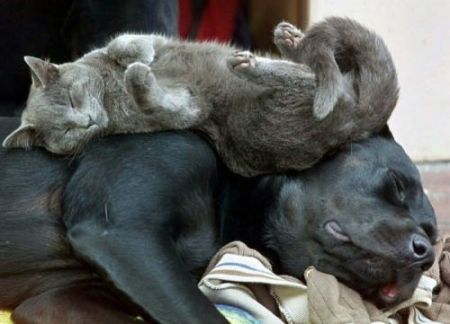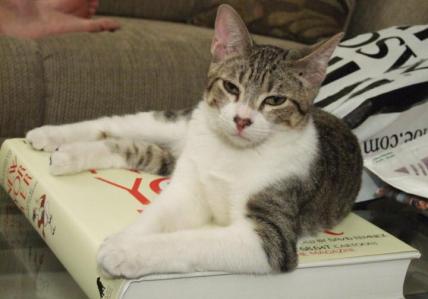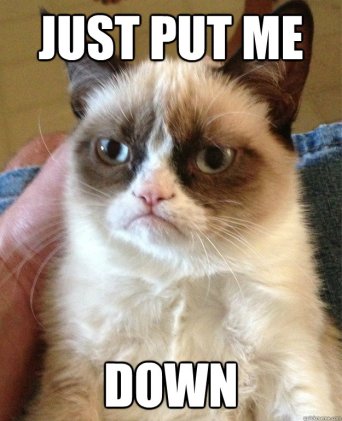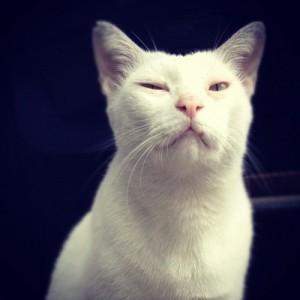Events tend to happen in a linear fashion, unless you’re from Tralfamadore. We mere Earthlings have to tell stories with some semblance of respect for chronology. It’s because of this that learning how and when to use each tense is to your advantage. Here’s a visual aid that I most definitely didn’t spend an hour slaving over in Paintbrush.
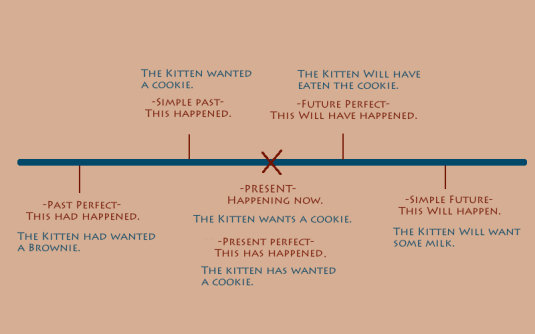
If the timeline tells us one thing, it is that cats always want what they can’t have. If it tells us two things, it should be that cats always want what they can’t have and that time works in a linear fashion and can be broken down into a specific sequence of events that we can naturally identify based on auxiliary verbs and verb forms.

Behold. The greediest of God’s creatures.
Let’s talk about the tenses individually so that we don’t confuse a cat. For fear of this blog repeating itself, let’s be brief on past perfect, since Julia has already eloquently explained it here.
The following explanations use examples of simple tenses, not continuous tenses, which will eventually get their own post.
Past Perfect Tense
When you’re talking about something that has happened, like a kitten’s watery eyes boring into your soul because it just wants that cookie so bad, you may encounter a situation where you need to provide some background for why the kitten is in your kitchen, because you don’t own a kitten. So you have your simple past: “This kitten stared at me with watery eyes.” But then your friends are staring at you openmouthed because you don’t own a kitten and they suspect you may have started stealing again, you klepto. Well, guess what? The past perfect is about to save your social reputation. “I had left the door open that morning to let in some fresh air, and a kitten walked in.” Your friends might be skeptical, but at least you gave them an explanation.

“I was just sitting in my front yard when the human ran up and snatched me…”
Past Tense
When you tell a story, your basic tense—the one where the majority of the action happens—will be past tense. There are a few exceptions to this, like:
- If you’re clairvoyant and are telling someone their future: My spirit guide wants me to tell you that a cat will pee on your shoe when the next full moon rises.
- If you’re writing a Choose Your Own Adventure book: You walk down the empty corridor and look to your left. Down the hall are identical twin kittens staring at you…but there haven’t been kittens in this building for eighteen years. If you want to run, turn to page…
- If you’re prefacing your story with a previous action (see the section on past perfect that you just read and should understand by now).
The narrator’s norm should be past tense, basically. So on the timeline above, the You Are Here for a narrator will generally be not at the present tense, but at the past tense and shift in either direction from there.

Cats don’t understand the You Are Here on a map.
Present Tense
This is the most happening of tenses.

Right. Sorry. No more puns.
The present tense is pretty handy. It can point out things that are happening right now. The most important use may be the warning.
“Watch out! There is a guard cat flying at your head!”

“Ach! Thwarted again by the present tense!”
We live in the present tense. Crazy, right? The present tense is, like, now. Don’t let it blow your mind. We tend to talk in the present tense when we talk about ourselves, which is most of the time. “I think,” “I like,” and “I want” are useful present tense tools. There’s not much more to say about it. I feel like it’s pretty easy to grasp. If you’re confused…sorry?
Present Perfect Tense
This tense, like all of the other perfect tenses, can generally fall anywhere during a particular range of time. For the present perfect, the event described will fall anywhere between the past tense and the present tense. It’s like the shortstop of tenses because it covers the the space in between those two points. The beginning of the verb could have started anywhere in the past, but the action or effects of that verb last until the present. Here is how it works versus the past tense.
Past tense: The kitten ate the cookie.
Present perfect tense: The kitten has eaten the cookie.
The difference between these two is that, while the present perfect talks about something that is in the past, it points toward the present. Imagine, if you will, that the present perfect event is a magic trick where the magician is making a cat disappear. There’s a process involved in that—put the cat in a box, rotate the box, allow magic to take place—but at some point between when the box is closed and when it’s opened, disappearing takes place. Now imagine the magician presenting this amazing feat: “Ladies and gentleman, the cat has vanished.” Any time you have trouble remembering what the present perfect is, ask yourself if a magician would use it to announce what has happened. Hopefully present perfect tense will seem wildly more entertaining to you with this new magic-related association.

Cats love purr-esent purr-fect. And magic.
Future Perfect Tense
The placement of future perfect on the timeline can be tricky, because you can’t go straight to it from present tense. Future perfect can only be used if it’s paired with the future tense (similar to how past perfect relates to past). For this reason, let’s skip over it, move onto future tense, and then come back.
Future Tense
Travel into the future with me for a second.

“I’m already there…here…in the future.”
No, astronaut grammar cat, not actually traveling into the future, because if we spoke about things in the future while we were in the future, then we would just be speaking about the present.
The future tense is handy because talking about things to come helps prepare us for things to come. For example,
- That kitten will grow up to be a cat.
- Your litter box will smell terrible when you get home.
- The Catfather will set you straight.

“I’m gonna make him an offer he can’t refuse.”
Good point, Catfather. While “will” is often used as the auxiliary verb to indicate that an event takes place in the future, there are other words that indicate the same thing. For example, “going to” (or “gonna” if you’re a lazy typist).
Here are a few other forms for talking about the future, using the subject “I” and the phrase “bathe the cat”:
- I shall bathe the cat.
- I am to bathe the cat.
- I am about to bathe the cat.
- I must go bathe the cat.
- I should go bathe the cat.
- I can go bathe the cat.
- I might go bathe the cat.

“You shall NOT bathe the cat.”
Future Perfect Tense (second attempt)
Now that we’ve ventured into the future tense, we can travel back from the future into the future perfect. This one works a lot like the past perfect. It’s used for talking about something that has happened between the present and the future. Yes, technically it is in the future itself, but it’s the present’s future, and the future’s past. This is something that will [indicating the future] have happened [notice the past tense verb]. Referring back to the timeline, we have the future of the kitten wanting milk, but before that, it will eat a cookie.
So, Before you know it, the kitten will have eaten its cookie and it will want some milk.
Putting it All Together
So it should all be clear, right?
Here’s the timeline again:

Now working off the examples of that timeline, we can create a short story (I used the word “story” loosely here, because nothing interesting actually happens). The story:
The kitten wants a cookie [present]. In fact, it has wanted [present perfect] one for quite some time. Before the kitten wanted a cookie [simple past], it had wanted a brownie [past perfect]. Before you know it, the kitten will have eaten the cookie [future perfect] and it will want some milk [simple future].

“Enough of your yapping. Give me a damn cookie already.”
